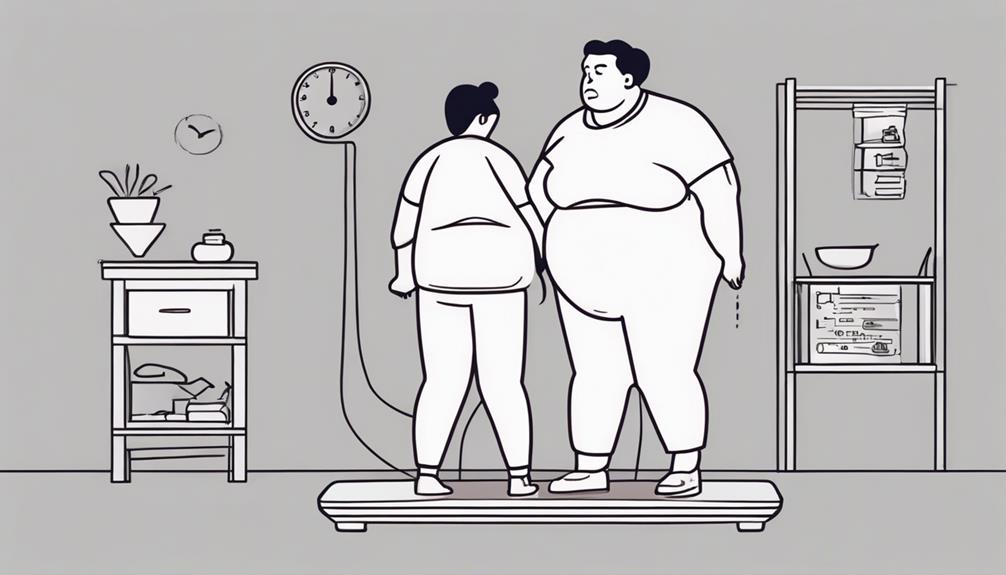Imagine your body as a finely tuned instrument, each element working in harmony. But what if there were early signs of discord, subtle cues that something wasn't right? Identifying these early indicators of Type 1 diabetes can be crucial for timely management and care.
Unexplained weight loss, extreme thirst, and other symptoms may be more than just passing issues. Understanding these signals could mean the difference between proactive health measures and unforeseen complications.
Key Takeaways
- Unexplained weight loss, extreme thirst, frequent urination, and fatigue are early signs of type 1 diabetes.
- Metabolic changes lead to weight loss, while elevated blood sugar levels cause thirst and hunger.
- Fatigue and weakness result from disrupted energy conversion due to lack of insulin.
- Blurred vision may indicate high blood sugar levels affecting the eyes, necessitating regular monitoring and professional consultation.
Unexplained Weight Loss

One of the early indicators of type 1 diabetes is unexplained weight loss, where individuals may experience a sudden and significant decrease in body weight without intentional changes in diet or exercise. This weight loss can be perplexing and alarming, especially when there's no apparent reason for it. In the context of type 1 diabetes, this phenomenon is often linked to metabolic changes within the body.
Metabolic changes play a crucial role in the unexplained weight loss experienced by individuals with type 1 diabetes. These changes can lead to alterations in how the body processes and utilizes energy. As a result, the individual may burn through calories more rapidly, contributing to the unintentional weight loss. Moreover, these metabolic shifts can also impact appetite regulation, causing fluctuations in hunger levels.
Understanding the connection between unexplained weight loss, metabolic changes, and type 1 diabetes is essential for early detection and management of the condition. By recognizing these signs early on, individuals can seek appropriate medical attention and begin necessary interventions to maintain their well-being.
Extreme Thirst and Hunger
Experiencing extreme thirst and hunger is a common symptom associated with the early stages of type 1 diabetes, indicating potential metabolic disruptions in your body. When blood sugar levels are elevated due to insufficient insulin levels, your cells are unable to access the glucose they need for energy. This lack of energy triggers your body to signal for more food intake, leading to increased hunger.
Moreover, the high blood sugar levels in type 1 diabetes can also cause excessive thirst. As your kidneys work to eliminate the excess glucose from your bloodstream through urine, they draw water from your body, resulting in dehydration. This dehydration triggers the sensation of extreme thirst, compelling you to drink more fluids to compensate for the fluid loss.
Therefore, if you find yourself constantly thirsty and hungry, especially coupled with unexplained weight loss, it's crucial to monitor your blood sugar levels and consult a healthcare professional for proper evaluation and diagnosis. Early detection and management are key in effectively handling type 1 diabetes.
Frequent Urination
The metabolic disturbances in type 1 diabetes that lead to extreme thirst and hunger are also responsible for causing frequent urination. When your body lacks insulin, glucose builds up in the bloodstream, drawing water from tissues. This excess glucose in the blood prompts the kidneys to work harder to filter and absorb the sugar, leading to increased urine production.
Frequent Urination in Type 1 Diabetes:
- Hydration Habits: Pay attention to your fluid intake. Excessive urination can lead to dehydration, making it crucial to maintain proper hydration levels.
- Bathroom Frequency: Monitor how often you're visiting the restroom. Frequent trips to urinate, especially during the night, could be a sign of underlying health issues.
- Urine Volume: Take note of the amount of urine you're producing. Large volumes of dilute urine may indicate potential diabetes-related complications.
- Timing: Observe if you need to urinate more frequently shortly after consuming sugary foods or beverages. This pattern could signal high blood sugar levels.
Fatigue and Weakness
Fatigue and weakness in type 1 diabetes often stem from the body's inability to efficiently convert glucose into energy due to a lack of insulin. When insulin is deficient, glucose can't enter cells to be used as fuel, leading to energy depletion. This results in feelings of weakness and fatigue, making daily activities more challenging.
Muscle fatigue is a common symptom experienced by individuals with type 1 diabetes. Without enough insulin, muscles receive less glucose, impairing their ability to function optimally. The lack of energy production in muscles contributes to the sensation of weakness and exhaustion.
The intricate balance between glucose and insulin is crucial for sustaining energy levels in the body. In type 1 diabetes, this balance is disrupted, causing a cascade of effects that manifest as fatigue and weakness. Understanding these early indicators can prompt timely intervention and management to improve overall well-being.
If you notice persistent fatigue and weakness, especially in conjunction with other symptoms, consulting a healthcare provider is essential for proper evaluation and potential diagnosis of type 1 diabetes.
Blurred Vision

Persistent high blood sugar levels in type 1 diabetes can lead to blurred vision as a result of fluid shifts in the lenses of the eyes. When experiencing vision changes, it's essential to consider the impact on your overall eye health. Here are four key points to help you understand the connection between blurred vision and type 1 diabetes:
- Fluid Imbalance: High blood sugar levels can cause the lenses in your eyes to swell, affecting their ability to focus properly.
- Temporary Blurriness: Blurred vision may come and go as your blood sugar levels fluctuate, making it crucial to monitor your levels regularly.
- Risk of Damage: Ignoring blurred vision can lead to long-term eye complications such as diabetic retinopathy, emphasizing the importance of early detection.
- Consultation: If you notice persistent or recurring blurred vision, consult with an eye care professional to assess your eye health and discuss potential interventions.
Understanding the correlation between blurred vision and type 1 diabetes can empower you to take proactive steps in managing your condition and safeguarding your eye health.
Frequently Asked Questions
What Are Some Potential Genetic Factors That May Increase the Risk of Developing Type 1 Diabetes?
You may have a genetic predisposition to type 1 diabetes, meaning certain genes increase your risk. Lifestyle factors like diet and exercise can also play a role. Understanding these connections is crucial for managing your health.
Are There Any Specific Dietary Recommendations or Restrictions That Can Help Prevent or Manage Type 1 Diabetes?
When it comes to managing type 1 diabetes, following specific nutritional guidelines is crucial. You should focus on balancing your meals to prevent blood sugar fluctuations. Making smart lifestyle choices can help you navigate this disease effectively.
How Does Physical Activity and Exercise Play a Role in Managing Type 1 Diabetes?
Regular physical activity and exercise positively influence blood glucose levels and improve insulin sensitivity in managing type 1 diabetes. Engaging in consistent workouts helps regulate blood sugar and enhances your body's ability to use insulin effectively.
Are There Any Alternative or Complementary Therapies That Can Be Beneficial for Individuals With Type 1 Diabetes?
Embracing alternative therapies like herbal remedies and mindfulness can complement traditional treatment for type 1 diabetes. Incorporating practices such as acupuncture and yoga may offer additional benefits, enhancing overall well-being and potentially improving management of the condition.
How Does Stress and Mental Health Impact the Management of Type 1 Diabetes?
Stress management is crucial for navigating type 1 diabetes. Utilize coping strategies to maintain emotional well-being, which impacts blood sugar levels. Mental health support is vital in the holistic management of this condition.
Conclusion
In conclusion, identifying early indicators of type 1 diabetes is crucial for early intervention and management of this chronic condition. Unexplained weight loss, extreme thirst and hunger, frequent urination, fatigue, weakness, and blurred vision are key symptoms to watch out for.
By recognizing these signs early on, individuals can seek medical attention promptly and take necessary steps to control their blood sugar levels. Remember, knowledge is power when it comes to managing diabetes effectively.